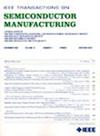sio2蚀刻过程中多等离子体信息的原位等离子体监测
IF 2.3
3区 工程技术
Q2 ENGINEERING, ELECTRICAL & ELECTRONIC
引用次数: 0
摘要
利用惰性气体进行发射光谱(OES)数据分析,称为稀有气体示踪法,已成为一种被广泛接受的等离子体过程监测方法。然而,由于在蚀刻中需要更高的硬掩膜选择性,它变得不太理想。传统的OES分析侧重于体等离子体特性,如电子温度和密度,但无法捕捉到欧姆加热和离子加速影响的蚀刻速率变化的全部复杂性。为了解决这些限制,我们提出了一种包含多个等离子体信息(PI)的替代方法,提供了一个更全面的等离子体机制视图。这个新框架被应用于开发一种基于oes的无惰性气体监测技术。通过调制源和偏置功率来改变欧姆加热和离子加速,与传统的基于ar的PI模型(~0.8)相比,多重PI模型显示出更高的$R^{2}$得分(~0.97)。此外,可解释的人工智能(XAI)表明,多个PI具有更大的重要性,证明了其在监测非惰性气体过程中的腐蚀速率方面的有效性。它不仅可以检测蚀刻过程中的变化,还可以确定变化是否源于化学或物理反应,从而对先进的过程控制有用。本文章由计算机程序翻译,如有差异,请以英文原文为准。
In-Situ Plasma Monitoring Using Multiple Plasma Information in SiO₂ Etch Process
Optical emission spectroscopy (OES) data analysis with inert gas, called rare gas tracing method, has become a widely accepted method for the monitoring of plasma process. However, it is becoming less desirable due to the need for a higher hardmask selectivity in etch. Conventional OES analysis focuses on bulk plasma properties, such as electron temperature and density, but fail to capture the full complexity of etch rate changes influenced by both ohmic heating and ion acceleration. To address these limitations, we propose an alternative approach that incorporates multiple plasma information (PI), offering a more comprehensive view of plasma mechanisms. This new framework was applied to develop an OES-based monitoring technique without inert gases. By modulating source and bias powers to vary both ohmic heating and ion acceleration, the multiple PI model demonstrated a higher $R^{2}$ score (~0.97) compared to the traditional Ar-based PI model (~0.8). In addition, explainable artificial intelligence (XAI) indicated that multiple PI had greater importance, demonstrating its effectiveness in monitoring etch rates in non-inert gas processes. It not only detects changes in the etch process, but also identifies whether the variations stem from chemical or physical reactions to be useful for advanced process control.
求助全文
通过发布文献求助,成功后即可免费获取论文全文。
去求助
来源期刊

IEEE Transactions on Semiconductor Manufacturing
工程技术-工程:电子与电气
CiteScore
5.20
自引率
11.10%
发文量
101
审稿时长
3.3 months
期刊介绍:
The IEEE Transactions on Semiconductor Manufacturing addresses the challenging problems of manufacturing complex microelectronic components, especially very large scale integrated circuits (VLSI). Manufacturing these products requires precision micropatterning, precise control of materials properties, ultraclean work environments, and complex interactions of chemical, physical, electrical and mechanical processes.
 求助内容:
求助内容: 应助结果提醒方式:
应助结果提醒方式:


